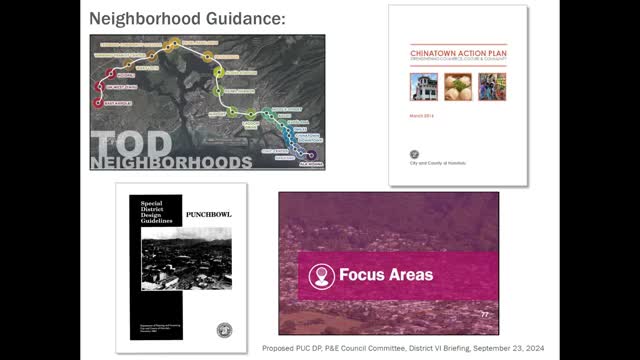Community Outcry Against Controversial Development Plan
September 23, 2024 | Honolulu City, Honolulu County, Hawaii
This article was created by AI summarizing key points discussed. AI makes mistakes, so for full details and context, please refer to the video of the full meeting. Please report any errors so we can fix them. Report an error »

In a recent government meeting, discussions centered on urban development and neighborhood planning in District 6, highlighting the importance of maintaining the character of historic areas while addressing modern needs. The focus areas identified in the Primary Urban Center Development Plan (PUCDP) aim to guide redevelopment in stable neighborhoods, particularly those that have not undergone recent planning processes.
Key topics included the designation of several special districts—Hawaii Capital, Chinatown, Punchbowl, and Thomas Square Academy of Arts—each designed to protect the unique architectural and natural features of these historically significant areas. The meeting referenced previous neighborhood planning efforts, such as the 2016 Chinatown Action Plan and the 2004 Kalihi Paloma Action Plan, which emphasized revitalization and infrastructure investment.
Specific focus areas within District 6 were outlined, including plans for downtown to encourage mixed-use development and improve pedestrian access to waterfronts. The Chinatown area aims to enhance public safety and refresh key promenades, while Evie Way is set for significant redevelopment from industrial to mixed-use transit-oriented development. Additionally, the upper Nuuanu and Liliha Streets area will support neighborhood-serving retail and promote \"missing middle\" housing.
The meeting also addressed climate-related challenges, particularly the need for infrastructure adaptations in light of projected sea level rise. Maps illustrating transit-supportive areas and existing parks were presented, emphasizing the importance of context-sensitive infill development.
Public testimony followed the presentation, with community members expressing concerns over specific developments, notably a project at 1617 Alapay Street. Residents voiced their opposition, citing a lack of community involvement in planning decisions and potential violations of special district guidelines.
The discussions underscored the delicate balance between preserving historical integrity and accommodating growth, as well as the necessity for community engagement in urban planning processes.
Key topics included the designation of several special districts—Hawaii Capital, Chinatown, Punchbowl, and Thomas Square Academy of Arts—each designed to protect the unique architectural and natural features of these historically significant areas. The meeting referenced previous neighborhood planning efforts, such as the 2016 Chinatown Action Plan and the 2004 Kalihi Paloma Action Plan, which emphasized revitalization and infrastructure investment.
Specific focus areas within District 6 were outlined, including plans for downtown to encourage mixed-use development and improve pedestrian access to waterfronts. The Chinatown area aims to enhance public safety and refresh key promenades, while Evie Way is set for significant redevelopment from industrial to mixed-use transit-oriented development. Additionally, the upper Nuuanu and Liliha Streets area will support neighborhood-serving retail and promote \"missing middle\" housing.
The meeting also addressed climate-related challenges, particularly the need for infrastructure adaptations in light of projected sea level rise. Maps illustrating transit-supportive areas and existing parks were presented, emphasizing the importance of context-sensitive infill development.
Public testimony followed the presentation, with community members expressing concerns over specific developments, notably a project at 1617 Alapay Street. Residents voiced their opposition, citing a lack of community involvement in planning decisions and potential violations of special district guidelines.
The discussions underscored the delicate balance between preserving historical integrity and accommodating growth, as well as the necessity for community engagement in urban planning processes.
View full meeting
This article is based on a recent meeting—watch the full video and explore the complete transcript for deeper insights into the discussion.
View full meeting
